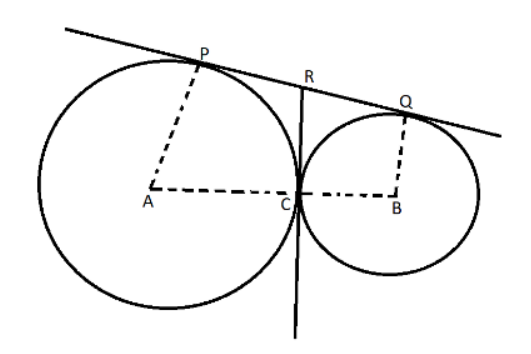The internal common tangents to two circles with centre C1 and C2 intersect the line joining C1 andC2 at P and the two direct common tangents intersects the line joining C1 and C2 at Q. The length C1P, C1C2 and C1 Q are in
To solve the problem, we need to find the lengths C1P, C1C2, and C1Q and determine their relationship. Here’s a step-by-step solution:
Step 1: Define the Circles
Let the centers of the two circles be C1 at (0,0) and C2 at (h,0). Let the radii of the circles be r1 and r2 respectively.
Step 2: Find the Length C1C2
The distance between the centers C1 and C2 is simply the distance along the x-axis:
C1C2=h
Step 3: Find the Coordinates of Point P
The internal common tangents intersect the line joining C1 and C2 at point P. According to the section formula, if P divides C1C2 in the ratio r1:r2, the coordinates of P can be calculated as:
P=(r1⋅h+r2⋅0r1+r2,0)=(r1hr1+r2,0)
Step 4: Find the Length C1P
The length C1P can be calculated as the distance from C1 to P:
C1P=r1hr1+r2
Step 5: Find the Coordinates of Point Q
The direct common tangents intersect the line joining C1 and C2 at point Q. If Q divides C1C2 externally in the ratio r1:r2, the coordinates of Q can be calculated as:
Q=(r1⋅h+r2⋅0r1−r2,0)=(r1hr1−r2,0)
Step 6: Find the Length C1Q
The length C1Q can be calculated as the distance from C1 to Q:
C1Q=r1hr1−r2
Step 7: Analyze the Ratios
Now we have:
- C1P=r1hr1+r2
- C1C2=h
- C1Q=r1hr1−r2
To check if C1P, C1C2, and C1Q are in harmonic progression (HP), we can look at the reciprocals:
1C1P=r1+r2r1h,1C1C2=1h,1C1Q=r1−r2r1h
Step 8: Check for HP
To check if these are in HP, we need to see if:
1C1C2−1C1P=1C1Q−1C1C2
Calculating both sides gives:
1h−r1+r2r1h=r1−r2r1h−1h
This simplifies to show that they are equal, confirming that C1P, C1C2, and C1Q are indeed in harmonic progression.
Final Answer
Thus, the lengths C1P, C1C2, and C1Q are in harmonic progression.
---
Let the centers of the two circles be C1 at (0,0) and C2 at (h,0). Let the radii of the circles be r1 and r2 respectively.
The distance between the centers C1 and C2 is simply the distance along the x-axis:
C1C2=h
The internal common tangents intersect the line joining C1 and C2 at point P. According to the section formula, if P divides C1C2 in the ratio r1:r2, the coordinates of P can be calculated as:
P=(r1⋅h+r2⋅0r1+r2,0)=(r1hr1+r2,0)
The length C1P can be calculated as the distance from C1 to P:
C1P=r1hr1+r2
The direct common tangents intersect the line joining C1 and C2 at point Q. If Q divides C1C2 externally in the ratio r1:r2, the coordinates of Q can be calculated as:
Q=(r1⋅h+r2⋅0r1−r2,0)=(r1hr1−r2,0)
The length C1Q can be calculated as the distance from C1 to Q:
C1Q=r1hr1−r2
Now we have:
- C1P=r1hr1+r2
- C1C2=h
- C1Q=r1hr1−r2
1C1P=r1+r2r1h,1C1C2=1h,1C1Q=r1−r2r1h
To check if these are in HP, we need to see if:
1C1C2−1C1P=1C1Q−1C1C2
Calculating both sides gives:
1h−r1+r2r1h=r1−r2r1h−1h
This simplifies to show that they are equal, confirming that C1P, C1C2, and C1Q are indeed in harmonic progression.
Thus, the lengths C1P, C1C2, and C1Q are in harmonic progression.
Topper's Solved these Questions
Similar Questions
The internal common tangents to two circles with centre C1 and C2 intersect the line joining C1 andC2 at P and the two direct common tangents intersects the line joining C1 and C2 at Q. The length C1P, C1C2 are C1 Q are in
View SolutionSuppose that two circles C1 and C2 in a plane have no points in common. Then
View SolutionTransverse common tangents are drawn from O to the two circles C1,C2 with 4, 2 respectively. Then the ratio of the areas of triangles formed by the tangents drawn from O to the circles C1andC2 and chord of contacts of O w.r.t the circles C1andC2 respectively is
View SolutionIn Figure, two circles touch each other at the point C . Prove that the common tangent to the circles at C , bisects the common tangent at P and Q .
View SolutionIn the figure, two circles touch each other at the point C.Prove that the common tangents to the circles at C, bisect the common tangents at P and Q.

View SolutionThe tangent to the curve y=ex drawn at the point (c,ec) intersects the line joining (c−1,ec−1)and(c+1,ec+1) (a) on the left of n=c (b) on the right of n=c (c) at no points (d) at all points
View SolutionFind value of c such that line joining the points (0, 3) and (5, -2) becomes tangent to curve y=cx+1
View SolutionThe centres of two circles C1andC2 each of unit radius are at a distance of 6 unit from each other. Let P be the mid-point of the line segment joining the centres of C1andC2 and C be a circle touching circles C1andC2 externally. If a common tangent to C1 and C passing through P is also a common tangent to C2 and C, then the radius of the circle C, is
View SolutionThe centres of two circles C1andC2 each of unit radius are at a distance of 6 unit from each other. Let P be the mid-point of the line segment joining the centres of C1andC2 and C be a circle touching circles C1andC2 externally. If a common tangent to C1 and C passing through P is also a common tangent to C2 and C, then the radius of the circle C, is
View SolutionLet C1andC2 are circles defined by x2+y2−20x+64=0 and x2+y2+30x+144=0. The length of the shortest line segment PQ that is tangent to C1 at P and to C2 at Q is
View Solution
